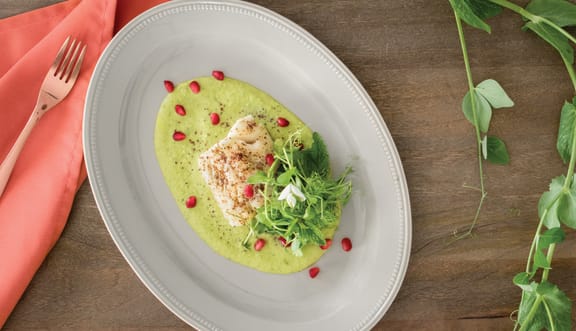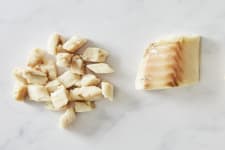Photo courtesy of Alaska Seafood Marketing Institiute (ASMI)
Mild enough to take on a wide variety of flavor profiles, wild Alaska pollock ought to be at the top of your list when you’re craving a baked seafood dish. Lean and firm in texture, this abundant variety of wild-caught seafood makes casseroles, pies, and one-dish fish bakes a cinch to make.
Our wild Alaska pollock is pre-cubed and portioned into 6 oz. packs of “quick cuts.” Prepared this way, these skinless, boneless quick cuts are the epitome of convenience, cutting your seafood prep routine down to practically nothing — all you have to do is cut open the package, arrange your pieces of pollock into a baking dish, and cover the fish with whatever sauce or topping you’re in the mood for.
Beyond convenience, wild Alaska pollock quick cuts are sized to cook through evenly and quickly, but they’re chunky enough to withstand longer bake times for recipes like pies, staying intact without drying out. The pollock quick cuts also happen to be the perfect size to enjoy in a baked dish when you want every forkful to hold a hearty bite of protein.
Baked Pollock Basics
The lean, mild, and flaky qualities of wild Alaska pollock make it a classic style of fish to use in any baked fish dish, either as the star protein or combined with another variety of seafood. If you’re adding other types of seafood into the bake, we suggest cutting it into pieces that are more or less uniform with the pollock so that everything will end up cooking as evenly as possible.
When using pollock quick cuts for a fish bake, you’ll almost always need to integrate at least a small amount of liquid in the dish, whether it’s a handful of juicy tomatoes that will stew down as they cook, a creamy bechamel to pour over the fish, or a splash of stock that will turn into something saucy by the time the bake has finished cooking.
Note: Without using something liquid, your pollock quick cuts are going to come out dry; if you want straightforward, oven-baked pollock without the casserole-type treatment, you’re much better off broiling the fish rather than baking it, as this hot and fast cooking method allows the pollock to retain its natural moisture and tenderness as it cooks.
As for the topping of a fish bake, you can use a buttery pie crust, creamy mashed potatoes, crispy breadcrumbs, or a generous layer of cheese. This topping, often, is what will determine the total cook time of your pollock bake; pie crusts need time to bake, potatoes are dense and need time to heat through, while something like breadcrumbs and cheese will toast/melt relatively quickly (and can see their full potential when they’re finished under a broiler).
The Process
Preheat your oven to anywhere between 375 degrees and 425 degrees; the temperature will usually depend on the topping you’re using, since something like a dough crust will benefit from a hotter oven while a tomato-and-veggie-based bake can use a gentler heat in order to have time to release their juices into the pan.
Meanwhile, get your ingredients prepped and arranged into a casserole dish or other baking vessel; pollock quick cuts will just need to be seasoned with salt and pepper, as there’s no reason to pat them dry when using them in a fish bake. However you decide to layer your ingredients into the baking dish, make sure that your quick cuts are nestled into any liquid or juicy ingredients that you’re using. They don’t need to be fully covered with liquid, but you’ll want to situate them so that they can baste in juices that form as the meal bakes.
As far as cook times go, again, it depends on your topping. If you’re not sure, simply set your timer for 12 minutes, then transfer your baking dish to the oven. That’s all the pollock needs to cook through.
At the 12-minute mark, you can peek at the dish to see if you’d like things to be cooked down more or to pick up a more golden crust, extending the cook time as you see fit. When the pollock bakes looks done, you can remove it from the oven or give it a quick blast under the broiler when appropriate.
Once out of the oven, you’ll ideally like the bake to rest for a few minutes before serving so that your servings of the dish will hold their shape a bit better. Enjoy hot or at room temperature, and definitely look forward to refrigerating any leftovers to eat over the next few days.
Baked Pollock Recipe Ideas
Check out our list of pollock pie and casserole recipes in our blog post that covers everything from a Mediterranean-style bake to a fish pie to a gnocchi and pollock gratin. And we’ve got a few more baked pollock ideas for you in our list of potluck-friendly fish dishes.






